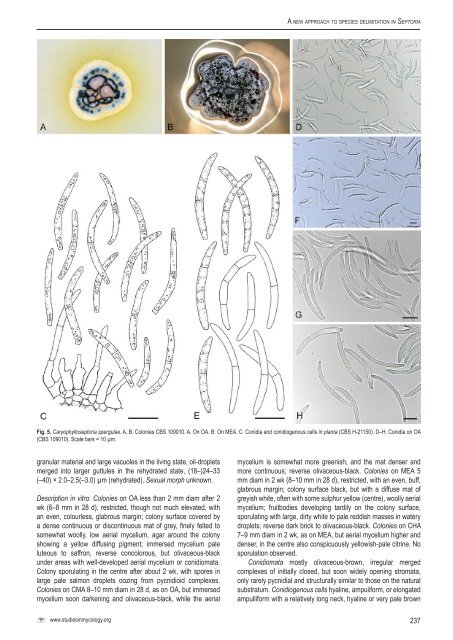A new approach to species delimitation in Septoria - CBS - KNAW
A new approach to species delimitation in Septoria - CBS - KNAW
A new approach to species delimitation in Septoria - CBS - KNAW
You also want an ePaper? Increase the reach of your titles
YUMPU automatically turns print PDFs into web optimized ePapers that Google loves.
A <strong>new</strong> <strong>approach</strong> <strong>to</strong> <strong>species</strong> <strong>delimitation</strong> <strong>in</strong> Sep<strong>to</strong>riaFig. 5. Caryophyllosep<strong>to</strong>ria spergulae. A, B. Colonies <strong>CBS</strong> 109010. A. On OA. B. On MEA. C. Conidia and conidiogenous cells <strong>in</strong> planta (<strong>CBS</strong> H-21150). D–H. Conidia on OA(<strong>CBS</strong> 109010). Scale bars = 10 µm.granular material and large vacuoles <strong>in</strong> the liv<strong>in</strong>g state, oil-dropletsmerged <strong>in</strong><strong>to</strong> larger guttules <strong>in</strong> the rehydrated state, (18–)24–33(–40) × 2.0–2.5(–3.0) µm (rehydrated). Sexual morph unknown.Description <strong>in</strong> vitro: Colonies on OA less than 2 mm diam after 2wk (6–8 mm <strong>in</strong> 28 d), restricted, though not much elevated, withan even, colourless, glabrous marg<strong>in</strong>; colony surface covered bya dense cont<strong>in</strong>uous or discont<strong>in</strong>uous mat of grey, f<strong>in</strong>ely felted <strong>to</strong>somewhat woolly, low aerial mycelium, agar around the colonyshow<strong>in</strong>g a yellow diffus<strong>in</strong>g pigment; immersed mycelium paleluteous <strong>to</strong> saffron, reverse concolorous, but olivaceous-blackunder areas with well-developed aerial mycelium or conidiomata.Colony sporulat<strong>in</strong>g <strong>in</strong> the centre after about 2 wk, with spores <strong>in</strong>large pale salmon droplets ooz<strong>in</strong>g from pycnidioid complexes.Colonies on CMA 8–10 mm diam <strong>in</strong> 28 d, as on OA, but immersedmycelium soon darken<strong>in</strong>g and olivaceous-black, while the aerialmycelium is somewhat more greenish, and the mat denser andmore cont<strong>in</strong>uous; reverse olivaceous-black. Colonies on MEA 5mm diam <strong>in</strong> 2 wk (8–10 mm <strong>in</strong> 28 d), restricted, with an even, buff,glabrous marg<strong>in</strong>; colony surface black, but with a diffuse mat ofgreyish white, often with some sulphur yellow (centre), woolly aerialmycelium; fruitbodies develop<strong>in</strong>g tardily on the colony surface,sporulat<strong>in</strong>g with large, dirty white <strong>to</strong> pale reddish masses <strong>in</strong> waterydroplets; reverse dark brick <strong>to</strong> olivaceous-black. Colonies on CHA7–9 mm diam <strong>in</strong> 2 wk, as on MEA, but aerial mycelium higher anddenser, <strong>in</strong> the centre also conspicuously yellowish-pale citr<strong>in</strong>e. Nosporulation observed.Conidiomata mostly olivaceous-brown, irregular mergedcomplexes of <strong>in</strong>itially closed, but soon widely open<strong>in</strong>g stromata,only rarely pycnidial and structurally similar <strong>to</strong> those on the naturalsubstratum. Conidiogenous cells hyal<strong>in</strong>e, ampuliform, or elongatedampulliform with a relatively long neck, hyal<strong>in</strong>e or very pale brownwww.studies<strong>in</strong>mycology.org237
















